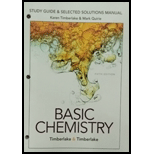
(a)
Interpretation:
The name of the Li+ ion should be determined.
Concept Introduction:
Any element which looses electrons in its molten or aqueous state to form a positively charged ion is known as cation whereas an element which gains electron in molten or aqueous state is known as anion. An ionic compound is formed by these cations and anions. The electrostatic forces of attraction are responsible for the formation of these compounds and they have ionic bond present between these cations and anions in the lattice structure.
(b)
Interpretation:
The name of the Ca2+ ion should be determined.
Concept Introduction:
Any element which looses electrons in its molten or aqueous state to form a positively charged ion is known as cation whereas an element which gains electron in molten or aqueous state is known as anion. An ionic compound is formed by these cations and anions. The electrostatic forces of attraction are responsible for the formation of these compounds and they have ionic bond present between these cations and anions in the lattice structure.
(c)
Interpretation:
The name of the Ga3+ ion should be determined.
Concept Introduction:
Any element which looses electrons in its molten or aqueous state to form a positively charged ion is known as cation whereas an element which gains electron in molten or aqueous state is known as anion. An ionic compound is formed by these cations and anions. The electrostatic forces of attraction are responsible for the formation of these compounds and they have ionic bond present between these cations and anions in the lattice structure.
(d)
Interpretation:
The name of the P3- ion should be determined.
Concept Introduction:
Any element which looses electrons in its molten or aqueous state to form a positively charged ion is known as cation whereas an element which gains electron in molten or aqueous state is known as anion. An ionic compound is formed by these cations and anions. The electrostatic forces of attraction are responsible for the formation of these compounds and they have ionic bond present between these cations and anions in the lattice structure.
Want to see the full answer?
Check out a sample textbook solution
Chapter 6 Solutions
Study Guide and Selected Solutions Manual for Basic Chemistry
 ChemistryChemistryISBN:9781305957404Author:Steven S. Zumdahl, Susan A. Zumdahl, Donald J. DeCostePublisher:Cengage Learning
ChemistryChemistryISBN:9781305957404Author:Steven S. Zumdahl, Susan A. Zumdahl, Donald J. DeCostePublisher:Cengage Learning ChemistryChemistryISBN:9781259911156Author:Raymond Chang Dr., Jason Overby ProfessorPublisher:McGraw-Hill Education
ChemistryChemistryISBN:9781259911156Author:Raymond Chang Dr., Jason Overby ProfessorPublisher:McGraw-Hill Education Principles of Instrumental AnalysisChemistryISBN:9781305577213Author:Douglas A. Skoog, F. James Holler, Stanley R. CrouchPublisher:Cengage Learning
Principles of Instrumental AnalysisChemistryISBN:9781305577213Author:Douglas A. Skoog, F. James Holler, Stanley R. CrouchPublisher:Cengage Learning Organic ChemistryChemistryISBN:9780078021558Author:Janice Gorzynski Smith Dr.Publisher:McGraw-Hill Education
Organic ChemistryChemistryISBN:9780078021558Author:Janice Gorzynski Smith Dr.Publisher:McGraw-Hill Education Chemistry: Principles and ReactionsChemistryISBN:9781305079373Author:William L. Masterton, Cecile N. HurleyPublisher:Cengage Learning
Chemistry: Principles and ReactionsChemistryISBN:9781305079373Author:William L. Masterton, Cecile N. HurleyPublisher:Cengage Learning Elementary Principles of Chemical Processes, Bind...ChemistryISBN:9781118431221Author:Richard M. Felder, Ronald W. Rousseau, Lisa G. BullardPublisher:WILEY
Elementary Principles of Chemical Processes, Bind...ChemistryISBN:9781118431221Author:Richard M. Felder, Ronald W. Rousseau, Lisa G. BullardPublisher:WILEY





